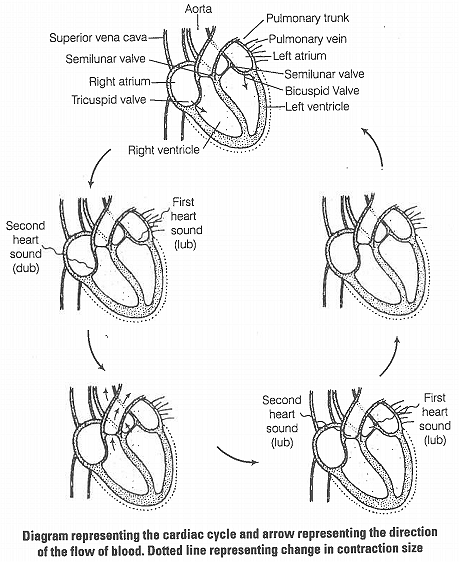The cardiac cycle consist of one heart beat or one cycle of contraction and relaxation i.e., takes place in the cardiac muscles. During the heart beat there is a contraction and relaxation of atria and ventricles. The contraction phase is referred as systole while the relaxation phase is called as diastole.
The successive events of the cardiac cycle are briefly described as below
(i) Atrial Systole The atria contract due to the wave of contraction, stimulated by the SA node. The blood is forced into the ventricles as the bicuspid and tricuspid valves are open.
(ii) Beginning of Ventricular Systole The contraction of ventricles begin due to the wave of contraction stimulated by AV node. This led to the closing of bicuspid and tricuspid valve producing part of first heart sound, i.e., lub.
(iii) Complete Ventricular Systole After ventricular contraction, the blood flows into the pulmonary trunk and aorta as the semilunar valves open.
(d) Beginning of the Ventricular Diastole The ventricles relax and the semilunar valves are closed. This cause the second heart sound, i.e., dub.
(e) Complete Ventricular Diastole The opening oftricuspid and bicuspid valves due to fall in pressure of ventricles and blood flows from the atria into the ventricles. Contraction of the heart does not cause this blood to flow, backward direction, due to the fact that the pressure within the relaxed ventricles is less than that of the atria and veins.
The duration of cardiac cycle last for 0.8 sec.
In double circulation, the blood passes twice through the heart during one complete cycle.
Double circulation is carried out by two ways
(i) Pulmonary circulation
(ii) Systemic circulation
Significance of Double Circulation In birds and mammals, two separate circulatory pathways are present. Oxygenated and deoxygenated blood received by the left and right atria respectively passes on to the ventricles of the same sides. The ventricles pump it out without mixing the oxygenated and deoxygenated blood in the heart.

